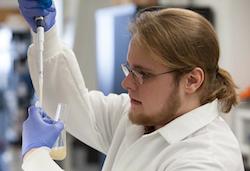Quinn Dickinson, research specialist at the University of Madison’s Wisconsin Energy Institute who also works with the Great Lakes Bioenergy Research Center (GLBRC), has helped to design a new strain of yeast that he believes holds great promise in improving the efficiency of making biofuel from biomass such as switchgrass.
Dickinson’s goal is to solve a problem in the biomass to biofuels conversion process, namely that in some cases, solvents are so good at breaking down biomass that they often hinder the next critical step of the process, fermentation.

GLBRC assistant research specialist Quinn Dickinson picks a colony of a new yeast strain that could reduce the cost of biofuels produced with ionic liquids.
The precursor to this finding was research Dickinson was conducting with fellow GLBRC colleague, Jeff Piotrowski, who is now a principal scientist at Yumanity Therapeutics in Massachusetts. The two were working on ionic liquids, solvents that can deconstruct different kinds of biomass into relatively pure streams of the plant’s sugar but which are also toxic to the kind of microorganisms that ferment those sugars into fuel.
“Ionic liquids are a particularly promising technology for deconstructing biomass, but their toxicity to fermentative microbes has posed a challenge,” said Piotrowski. “To really harness the power of this solvent — and to enable a bio-based economy — we need microbes specifically tailored to tolerate the specific toxicity of ionic liquids.”
Thus, using a technique called chemical genomics, Dickinson and Piotrowski set out to create a yeast strain that could tolerate ionic liquids. They found that by identifying a number of genes in an industrially relevant yeast strain that, when deleted, either made the yeast sensitive to ionic liquids or resistant to them, they were able to understand the precise nature of ionic liquids’ toxicity to yeast. From there, they engineered a new strain of yeast that shows resistance to ionic liquids but simultaneously improves sugar conversion and biofuel production. The finding also reduces a step in the process and has the potential to lower the cost of biofuel production.
“What this work shows more broadly is that we can use chemical genomics to rapidly design new yeast strains in response to any new chemical compound, or any new solvent used as part of a new bioconversion technology,” explained Dickinson. “Drugs and green chemicals, many of these products are also produced with yeast and other engineered microbes.” He added, “This approach provides a paradigm for engineering tolerance that could improve the process of making those products too.”

